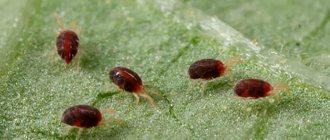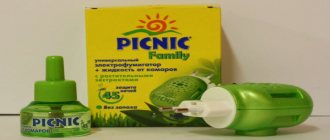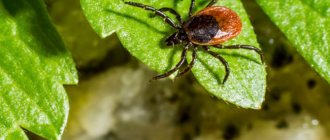Ixodid ticks are dangerous blood-sucking parasites, common in almost all climatic zones. In the Arctic and Antarctic they attack birds and penguins. In Russia, arachnids ruin people's lives by attacking them in nature. Ticks are difficult to control due to their small size, incredible survival rate, and resistance to negative external factors. The process is aggravated by the fact that blood-sucking parasites often choose to bite areas of the body that are hidden from human eyes during a cursory examination.
Not every person is ready to use chemical methods of protection against ticks. But these parasites pose a serious danger to people, they carry pathogens of dangerous and even fatal diseases (the well-known encephalitis and borreliosis). Today, the risk of encountering blood-sucking individuals is present everywhere: at a summer cottage, in the forest, in city parks, even in the courtyard of a house. Below we will consider popular folk remedies for ticks, their features and effectiveness. They are based mainly on the use of natural ingredients and household chemicals that can be found in every home.
Essential oils, vanilla
Parasites are repelled by an unpleasant odor, which is why the products most often used contain ethers. Anti-tick oil is very simple to prepare; just mix a few ingredients and the product is ready.
The most effective are clove oil against ticks, lemongrass, mint, chamomile, lavender, basil, geranium, and thyme. The list goes on and on. All plants contain oils, so experts recommend drinking tea with the addition of such plants, for example, basil. But their use internally must be done carefully, since there is a risk of developing an allergic reaction due to intolerance to the components.
Anti-tick essential oils for children or adults contain the following:
- water – 100 ml;
- alcohol – 10 ml;
- selected oil – 10 ml.
Pour the ingredients into a spray bottle and shake well. To prevent the aroma from scaring people away, esters with a pleasant aroma are added to it, such as coconut, shea, and almond.
What oil repels ticks? Another effective remedy for parasites has the following composition:
- palmarosa or geranium ether – 15 drops;
- base oil (almond) – two tablespoons.
Combine the oils and pour into a dark bottle; this mixture can be stored for up to six months. Apply to the surface of skin, clothing, shoes (a few drops). For small children, you can make special scented bracelets: apply a few drops of ether to a braid or ribbon and put it on the child’s hand.
When going to the forest or walking in the park with your whole family and pets, you need to protect yourself as thoroughly as possible from ticks. Natural parasite repellent includes geranium esters and almond oil. This composition should be stored in the refrigerator and used when necessary. To protect the animal, it is necessary to lubricate the withers, back or collar - those places that the dog does not need to lick.
If you are outside all day, you need to use protective equipment every 2-3 hours. It is worth remembering that such folk remedies cannot provide 100% protection against parasites, so you should be vigilant, wear only closed clothing in the forest or park, and upon returning home, conduct a thorough examination of the skin to exclude bites.
Vanilla has a pleasant aroma, but despite this, this spice is repulsive to ticks. To prepare sweet vanilla water you will need:
- liter of water;
- a few grams of vanillin.
Vanillin should be poured into water, put on fire to boil, then cooled and applied with a cotton pad to exposed areas of the body or the surface of clothing. For more reliable protection, it should be used every 2 hours.
To protect adults, vanilla tincture is suitable. To prepare it, you need to mix 100 ml of alcohol and a few grams of vanillin, place it in a dark bottle, and let it brew for a week. Treat the skin with the resulting solution.
Simple rules
The first thing you need to remember before going on a picnic is appropriate clothing. T-shirts and shorts will have to be put aside. You can prevent ticks from getting on your skin by wearing thick pants, a long-sleeve sweater, a hat, and closed shoes.
It is much easier to spot insects if you choose light-colored clothing. You need to look at yourself and your loved ones often while being in nature. It is also advisable to avoid tall grass and bushes, where ticks usually prefer to live.
Upon returning home, it is worthwhile to carefully examine the entire body again. It is recommended to pay special attention to the scalp.
Recipes for preparing tick repellents
In order to prepare a folk remedy for ticks, you need to use one of the listed essential oils, as well as other additional components that will not only provide maximum protection against parasites, but also provide aromatherapy.
What don't ticks like? Alcohol or vinegar - strong odors that repel insects, enhance the effect of sprays, but please note that these components are only suitable for adults.
Alcohol spray includes the following components:
- glass of water;
- two tablespoons of alcohol;
- two tablespoons of geranium oil.
Pour the ingredients into the bottle and shake well, store in a cool place and use as needed. The shelf life is about six months; it can be applied to skin and clothing using a spray bottle.
The dangerous insect cannot tolerate the ant smell, so while walking in the forest you should spray your shoes and outerwear with the product. To prepare tick poison, you will need formic alcohol - 200 ml, water - 200 ml and any essential oil as desired. Mix the ingredients and place in a spray bottle. Use outdoors every three hours.
Another effective remedy against parasites contains vinegar and other additional components:
- 4 tablespoons of vinegar;
- 2 tablespoons of water;
- eucalyptus or mint ether – 15 drops.
Pour the components into the bottle and shake well, store in the refrigerator for no longer than six months. The product can be applied to both clothing and skin.
Valerian. Ticks don't like its smell. Recipe for application to skin or protective clothing:
- cologne or alcohol - one spoon;
- valerian drops – 10 drops.
Mix the ingredients and pour into a resealable bottle; you can store for no more than 6 months. To apply the elixir to the skin, use a cotton sponge.
To prepare a spray that can be taken outdoors, you need to use tar soap, citrus esters and water - this composition is allowed to be used to protect animals and children. To prepare you will need:
- tar soap;
- oil of myrrh, juniper, oregano, thyme and grapefruit - a few drops each;
- glass of water.
Grind the soap using a grater, add the remaining ingredients and mix well. Apply to exposed skin before a walk or hike in the forest.
What else are ticks afraid of? Insects are repelled by the pungent odor of the “Zvezdochka” ointment. The ointment includes the following ingredients:
- “Star” ointment – on the tip of a small spoon;
- water – 200 ml;
- a little liquid soap;
- apple cider vinegar – 1 tsp.
Mix the ingredients and apply to the skin before starting your walk.
These are not all the ways to protect yourself from ticks using folk remedies. You can also prepare an aromatic gel with esters, consisting of geranium and lavender essential oils - 20 drops each, base oil (almond or vegetable) - 0.3 l and aloe gel - 150 ml. Mix the ingredients until smooth and put in a cool place. Apply, if necessary, to exposed areas of the body: neck, legs and arms.
Knowing what odors repel ticks, you can create your own recipe using pleasant aromas and effective repellers.
You should protect not only yourself, but also your pets, who often go for a walk or vacation with their owner. Parasites do not like specific odors such as garlic, wormwood and tar. Products prepared on their basis are suitable for use by the whole family.
Garlic against ticks is one of the effective and simple remedies. These “perfume” are prepared from water and a few cloves of garlic. Crush or finely chop the garlic, add a liter of water and let it brew overnight. Apply to the animal's fur, but be sure to apply to areas inaccessible for licking (withers or back).
Remedies for parasites should be as gentle as possible, since they are used to protect not only adults, but also children. Baby products are prepared from ingredients without strong odors such as cologne, vinegar or alcohol. Effective and safe components for preparing folk remedies for ticks are:
- vanillin;
- culinary cloves;
- almond oil;
- geranium ether;
- tea tree ether.
When using any products for external use, make sure there is no allergic reaction.
Parasites are not afraid of moisture or water, but if the liquid is used in combination with other components, then such a product will repel insects. For example, you can add vanillin, geranium, lavender or mint essential oil to a spray bottle of water. While walking in the park or in the forest, sprinkle exposed areas of the body with this water, which will protect against ticks and refresh in hot weather.
Using iodine after a tick bite is possible, but it is better to use other antiseptics, such as hydrogen peroxide.
Another thing is to use iodine as protection against the parasite. To do this, it is recommended to add a certain amount of iodine to a spray bottle with water and apply it to the exposed surface of the skin. Please note that the product may leave dark stains on light-colored clothing.
About the life characteristics and habits of parasites
To understand what ticks are afraid of, you should immediately divide this question into two separate topics (depending on the animal’s lifestyle).
For wild ticks, it is integrally associated with the characteristics of their life activity, including:
- parasitic lifestyle;
- seasonality in activity;
- living almost exclusively in the wild.
A fairly large tick that has entered the house can only be found attached to the body of an animal (cat, dog, cattle) walking outside the yard.
Since forest ticks feed only on blood, they are extremely sensitive to odors, by which they identify an approaching object as prey.
Tick on a leaf
And they will not confuse the smell of sweat or human body with any other. Suction is preceded by a slow crawling of the parasite, not perceived by the body, in search of a vulnerable spot.
But even the very process of penetration of the tick’s skin-piercing “instruments” into the victim’s body is almost not felt by a person, since along with saliva it injects an anesthetic - a chemical “local freezing”.
Tick bite site
Itching usually begins several hours after the moment of suction, but it is possible to notice (and more often, feel) the animal itself, swollen with blood, even later.
But there are parasites that are active all year round:
- indoor (dust mites);
- intradermal (scabies, demodex, ear).
Their sizes are so tiny that they can easily be carried into the home by the wind (the first ones), or on a grooming item for the same cat - on a hair comb (ears), or they can be transmitted through skin-to-skin contact (scabies). ).
Scabies mite under a microscope
The vital activity of microscopically small mites often does not manifest itself in anything other than itching, and is perceived as nervous itching, or changes in its structure that occur as a result of the onset of a certain age (menopause, puberty).
You can also read our article: Ticks in Crimea, what species live and are there encephalitic ones among them?
Ash, smoke from a fire or cigarettes
Anti-mite ashes or ash have a detrimental effect on the parasite.
Cold ash or ash immobilizes the pest and inflicts wounds on it, completely paralyzing it; after a while the parasite dies. Also, the smell of ash repels ticks, preventing them from approaching. One of the disadvantages of this tick repellent is that the ash can stain your clothes.
Ticks cannot tolerate the smell of smoke from a fire or cigarettes, so it is safest to be near a fire. In nature, it is advisable to use several methods of protection: closed clothing and sprays. But still, such measures cannot provide a 100% guarantee and complete protection from tick bites.
Making your own repellents
There are several ways to make tick repellent. Below we will look at several of them in more detail.
What to put on your dog against ticks: folk remedies
Pets also require protection when going for a walk in a park or forest. The problem is that the dog constantly licks itself, so the product used can enter the body, causing poisoning. Therefore, many people have a question: how and what to apply to a dog against ticks? One of the simplest options is to apply a few drops of essential oil to your pet’s collar.
It is important that the drug does not come into contact with the skin, as irritation may occur. Due to the fact that it quickly disappears in the fresh air, the collar should be treated every two hours.
Here we wrote in detail about what to do if a tick is found on a dog, signs of disease in the animal, possible consequences of the bite, treatment.
Also, a small amount of the product can be applied to the withers and back of the animal without affecting the skin.
A vaccinated person is not afraid of a bite
There is only one way to develop lasting immunity against tick-borne encephalitis - to get vaccinated against this infection. You can get vaccinated for free at any public clinic at your place of registration. Only effective, well-proven domestic vaccines are used - “Tick E-Vac” for children and “EnceVir” for adults. So, this year almost 4 thousand people have already been vaccinated in Moscow, and about a thousand in the Moscow region. In 2022, 33.7 thousand and 9.5 thousand residents were vaccinated, respectively.
As the press service of the capital's health department told RG, the standard vaccination regimen against tick-borne viral encephalitis consists of three preventive vaccinations.
The interval between the first and second is at least one month, and a year must pass between the second and third. To further maintain immunity, it is necessary to carry out a single booster vaccination every three years. This vaccine protects 95% of vaccinated people. But even if the disease occurs in vaccinated people, the disease occurs with fewer consequences.
Both adults and children (over 1 year old) can be vaccinated all year round without any restrictions. Experts from the department recommend planning vaccination in such a way that at least two weeks pass from the moment of the second vaccination before leaving for an endemic area. During this time, protective immunity should have time to form. And since May and June are considered the most dangerous months, those who, for example, are going to the Vologda region, should get vaccinated right now. But you just need to remember about contraindications - these include acute infectious and non-infectious diseases, as well as chronic diseases in the acute stage (for example, bronchial asthma). The vaccination should be done no earlier than a month after recovery.
First aid
Having prepared to go on a hike or just take a walk in nature and having figured out how to protect yourself from a tick attack, you also need to become familiar with the provision of prompt assistance if the parasite does bite you.
The bite itself is very difficult to notice, since the tick releases saliva, which numbs the wound. As soon as you find an insect, you need to try to get it out immediately.
- You should take nail tweezers or a special device. If there are no instruments, improvised means may be suitable. You need to take a thread, make a loop and put it around the proboscis.
- Having tightened the loop, you should carefully, rocking from side to side, pull out the tick, turning it around its axis.
Removing a tick using tweezers
If extraction is not carried out correctly, the head may come off and remain inside. Then you need to wipe the bite site with cotton wool soaked in alcohol and pull out the head with a needle pre-calcined in the fire, like a splinter. The wound should then be disinfected.
If you cannot remove the bloodsucker yourself, you need to go to the nearest trauma center.
Having pulled out the parasite, you need to place it in an airtight container, for example, a bottle of some medicine or put it inside a plastic bag, and tie the neck tightly.
Then you should fill out the label, indicating the full name and contact information of the victim, the date, time and place of discovery of the tick. After this, you should immediately contact an accredited laboratory to check the insect for infections.
How to treat the territory (summer cottage, forest clearing)?
To repel ticks, it is recommended to treat the area. The dacha plot is treated regularly in spring and autumn. Treatment is carried out on dry days; the treated area is not visited for 3–5 days. The table below shows a list of drugs that help protect a clearing, summer cottage or garden plot from blood-sucking insects:
| Name | Active substance | Description |
| Ram | Zeta-cypermethrin | Designed to kill ticks and other insects (mosquitoes, flies, fleas, ants, cockroaches and bedbugs). It is odorless, leaves no traces, and does not accumulate in plants and soil. |
| Cifox | Cypermethrin | With its help, they get rid of ticks over large areas. |
| Acaritox | Alpha-cypermethrin | White powdery product, pre-diluted in water. The resulting emulsion is used to treat the area. The drug is intended to kill cockroaches, bed bugs, fleas, ants, flies, mosquitoes, and ticks. |
| Force site | Fention | The product helps get rid of cockroaches, ants, bedbugs, fleas, flies, mosquitoes and ticks. |
| Medilis-CIPER | Cypermethrin | The preparation diluted in water is used to treat open areas and premises. |
A forest clearing for a picnic is not treated before settling down on it. The resting place is covered with branches of wormwood, flowering bird cherry, tansy - the smell of these plants will repel dangerous insects and help vacationers protect themselves from them.











